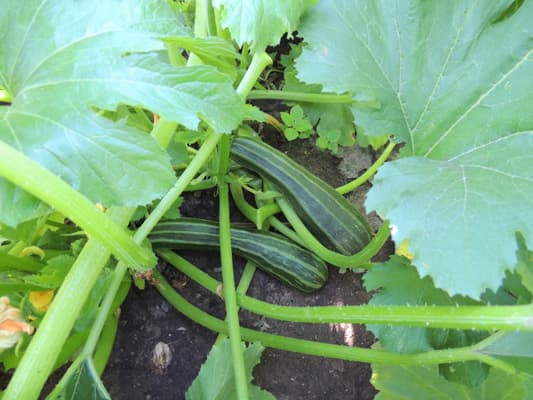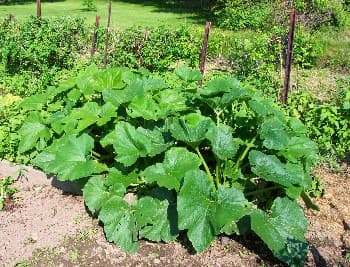How to Grow Zucchini Squash

Learn How to Grow Zucchini in Your Home Garden
Just about anyone can grow zucchini squash. It is one of the most prolific producers of all. And you hardly have to know how to grow zucchini. It is very easy to grow. As a result, you will find it growing in most home gardens. And perhaps best of all, there are literally hundreds of zucchini recipes.
Zucchini is a member of the squash and pumpkin (or Cucurbita) family of vegetables. It is perhaps the best known, and most joked about of the many varieties of squash. Zucchini is indeed an extremely prolific producer. A couple of plants in the garden, and you have plenty for family, neighbors, and friends. Then, by mid-summer, you can’t give zucchini away. Everyone you know has two or three on the kitchen counter, or in their refrigerators. Along with being a prolific producer, zucchini also readily crossbreeds with many members of the Cucurbita family, including pumpkins. Some very strange and interesting crossbreeds (Mutations!) can result in future crops if you save the seed. Enjoy them in generous quantities in the summer, as they are not good keepers. That’s why they are classified as a summer squash. When the gardening season is over, they are gone.
World Record Zucchini: We have all seen some pretty big monster zucchinis hiding under the luscious leaves of our plants. But, you just might not believe how big they can grow. Hint: It’s well over 60 pounds! World Record Giant Zucchini
Did You Know? Dogs can eat zucchini. And, it’s healthy for them, too.
Varieties of Zucchini Summer Squash
Zucchini is a summer squash. This family of squash has a soft, edible skin, with a short shelf life.
While many gardeners think of Zucchini as a specific variety, there are a few specific varieties with similar, yet different traits.
Popular, common varieties:
- Black Beauty – This Heirloom is the most popular variety. Dark green fruits taper toward each end. They are best picked when 6 to 8 inches in length. Large, big-leaved plants can sprawl across the garden as the season. progresses.
- Zucchini Bush – This space-saving variety is perfect for small gardens and containers. High yields and disease resistant.
- Zucchini Dark – Dark, dappled skin. It tastes great sliced, shredded, or cooked in your favorite recipe.
- Elite – The virus tolerant plant produces a high yield of green, yellow speckled fruit. Plants are less bushy than other varieties, making them easier to harvest.
- Garden Spineless – This variety offers great tasting zucchini without scratchy stems. Open growing habit, makes picking easier and painless.

How to Grow Zucchini - Season Long Care
Growing zucchini plants is easy, perhaps too easy. The plant produces a prolific amount of fruit over the growing season. It produces so much fruit, that just two or three plants is enough to keep a steady supply ready to pick for several weeks in the summer. Many gardeners plant more, and find themselves giving away zucchinis to family, friends, and neighbors. At peak harvest, it’s time to pull out your extensive list of zucchini recipes to help use all of the excess fruit. Zucchini is extremely easy to grow.
Plant in full sun. Zucchini plants will do well in average to rich soils. The plants like well-drained soil, but will grow in most soils.
Plant seeds in rows or hills, planting seeds one inch deep. Row spacing is dependent upon the variety you are planting. In hills, plant four to five per hill. After they have germinated, keep the best two to three zucchini plants. Water the first day and if there is no rain, every two to three days until they germinate.
We chuckle at the idea of adding fertilizer to such a great producer, but some soils are poor in nutrients. If your soil is poor, or if last year’s crop was less than stellar, a side dressing of fertilizer and regular feedings of fertilizer will significantly improve the health of the plant, and the size of the harvest.
Garden Growing Tip: An individual plant can produce fruit all the way to Fall frost. But, most plants lose their vigor or fall victim to insect and plant disease. It can also sprawl across the garden, with only the growing tip producing new fruit. We recommend a second planting right around the first of July. The second crop will be more vigorous and productive in the second half of the year, than an older plant
Ideal Soil pH: 6.0 – 7.5.
Also, See:
Plant Problems – causes and cures
Soil Temperatures – germination temperature by vegetable.
Insects and Pests
The Cucumber Beetle is the dreaded pest of the Cucurbita family. There is no exception for zucchini. Cucumber Beetles are either striped or spotted. They feed on the leaves of the plants and can cause even greater damage by spreading disease from one plant to another.
Squash Vine Borers are another huge threat. We consider Squash Vine Borers Public Enemy #1 of the Cucurbita family. They bore into the vine, near the base of the plant. Given a little time, they will chew right through the vine, killing the plant.
Cucumber Beetles are effectively controlled with most insecticides. Squash Vine Borers require stronger insecticides. Read the insecticide label, to make certain it is effective against Squash Vine Borers.
A variety of other pests can also cause problems, depending upon where you live.
Plant Disease
As a member of the Cucurbita family, zucchini plants are susceptible to a variety of bacteria and fungus diseases. Among the most common, are powdery mildew and bacterial wilt. Plant disease problems are most common in hot and humid weather, especially towards late August as the plant is aging and weakens. Promoting a strong, healthy plant, coupled with fungicide treatment, will help to avoid these problems.
Treat with fungicides at the first sign of problems.
Plant Problems – Diagnosis, causes, and cures for many common plant problems.
How to Grow Zucchini - HarvestTime
Days to Maturity: The plants are fast growers. Plant seeds today, and you will be eating them in about 45 to 55 days.
Like other summer squash, harvest when the fruit is young (four to six inches) and tender. Some people wait until the fruit becomes a monster. While still edible, it is tougher and the skin may need to be peeled.
Some people enjoy seeing just how big they can grow them! If this is you, grow one or two monsters for show. Pick small ones to eat.
Plant Hardiness
Zucchini plants are not hardy plant. It is susceptible to frost in the spring and fall. They are also very susceptible to insects and diseases. Fortunately, these prolific producers overcome these threats to produce a bountiful crop. As you plan to grow them, make sure those plans include how to use the large quantity you will have.
Zucchini Recipes
Without a doubt, in midsummer, we have more of this summer squash than we know what to do with. As a result, there’s also no shortage of zucchini recipes.
May we suggest:
Pumpkin Zucchini Nut Bread – Here is a neat recipe for some of that excess Zucchini.
Related Articles
People who read article also like:
Top Ten Signs You Have Too Much Zucchini
Sneak Some Zucchini on Your Neighbors Porch Day – Now here is a very special day for gardeners with way too much Zucchini!!!
Please support our site. Shop for:
- rmmatthews100@hotmail.com
- 585-721-6528
- Rochester, NY
©1999-2024 GardenersNet.Com, All Rights Reserved

